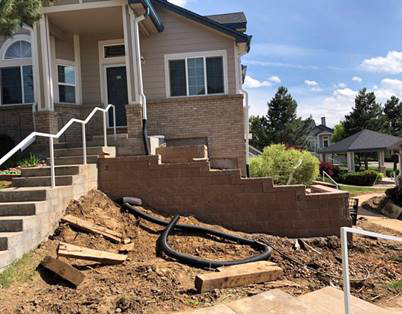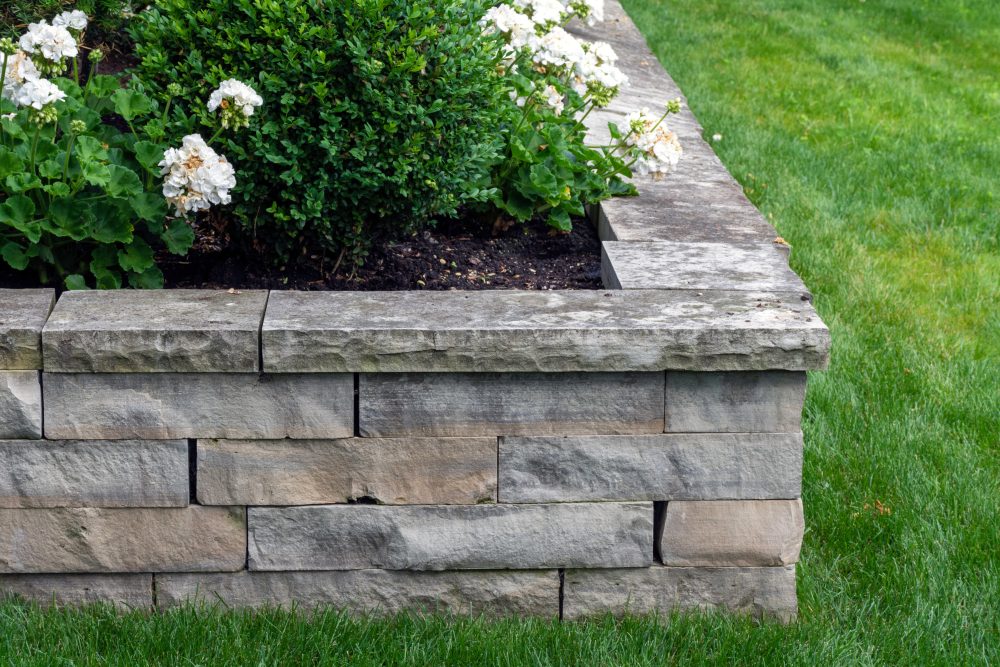Everything you should know about OKC Precision Retaining Walls and property drainage
Everything you should know about OKC Precision Retaining Walls and property drainage
Blog Article
Secret Considerations for Structure Effective Retaining Walls in Your Backyard
When you're taking into consideration constructing a preserving wall in your yard, it's important to believe regarding several crucial elements. The wall's purpose, the products you'll utilize, and the certain dirt problems can all impact its performance and durability. You'll also require to browse neighborhood structure codes and plan for appropriate water drainage. However exactly how do you assure your design not just satisfies these requirements however likewise improves your landscape? Allow's explore the necessary steps together.
Understanding the Objective of Your Retaining Wall
When you think of building a keeping wall, consider its major function: supporting soil and avoiding erosion. Retaining walls provide crucial support for sloped landscapes, assisting to maintain soil honesty. You'll find they're crucial in areas where water runoff could or else remove soil, causing pricey repair services and landscape damages.
By keeping back earth, these walls develop degree surface areas for gardens, outdoor patios, or paths. This not only improves your backyard's looks yet likewise advertises much better drainage, reducing water merging in undesirable locations. If you're dealing with high slopes, a sound retaining wall surface can protect against landslides, guaranteeing safety for you and your building.
Eventually, understanding the objective of your retaining wall surface will lead your layout decisions and aid you produce a useful, sturdy structure that meets your requirements. Take a moment to evaluate your landscape; it'll pay off in the long run.
Selecting the Right Materials
When picking products for your retaining wall surface, you'll intend to consider sturdiness, visual appeals, and cost. Each variable plays an important function in guaranteeing your wall surface stands the test of time while looking terrific and suitable your budget. Let's explore exactly how to make the very best options for your job.
Product Durability Elements
Choosing the right materials is essential for the longevity and effectiveness of your retaining wall surface, because their toughness straight impacts the wall's capability to endure environmental stress and anxieties. Start by considering your neighborhood climate; products like concrete and stone withstand wetness and temperature changes well. If you live in a location vulnerable to heavy rains, go with materials with excellent drainage buildings, like gravel or porous blocks, to stop water accumulation.
Some materials do much better in specific dirt types, so it's essential to match them as necessary. Picking long lasting materials warranties your retaining wall surface stands strong, shielding your lawn for years to come.
Aesthetic Layout Choices
Sturdy materials not just guarantee your retaining wall surface's structural stability but also play a vital function in its aesthetic appeal. When choosing the right materials, consider exactly how they complement your landscape. All-natural stone supplies an ageless, rustic look, while cinder block can give a streamlined, modern coating. You may also think about utilizing timber for a warm, organic feel. Shade and appearance issue, also; select shades that balance with your home and garden. Don't ignore the wall's shape-- bent walls can develop a softer look, while straight lines can feel more organized. By thoroughly selecting products that straighten with your aesthetic vision, you'll improve your exterior area while ensuring your wall surface stands solid against the elements.
Cost-Effectiveness Analysis
Choosing the best materials for your retaining wall isn't nearly looks; it's likewise crucial for your budget. When selecting products, think about both in advance prices and lasting toughness. Concrete blocks could be pricier initially, but their durability can conserve you money on repairs. On the other hand, wood can be more budget friendly but may call for substitute sooner.
Do not forget to aspect in upkeep prices also (OKC Precision Retaining Walls). Some materials, like natural stone, can include appeal and require much less maintenance, while others may need normal therapies
Ultimately, weigh the pros and disadvantages of each option versus your budget and the wall's designated function. Investing sensibly in products now can avoid pricey concerns later on. Choose products that stabilize cost and performance effectively.
Evaluating Dirt Problems and Drainage
As you begin your project, evaluating dirt conditions and drainage is essential for the success of your retaining wall. Beginning by analyzing the sort of soil in your lawn. Sandy dirt drains pipes well but lacks security, while clay soil can keep wetness, leading to pressure on your wall. Evaluate the dirt's dampness material by excavating a little hole and observing how promptly it dries.
Following, analyze the slope of your yard. If water naturally streams toward your wall, you'll need to implement a drain option to protect against erosion and pressure accumulation. Think about installing perforated pipelines or gravel backfill behind the wall to assist in drainage.
Lastly, observe any close-by trees or plant life; their origins can impact soil security. By recognizing your dirt problems and implementing correct drainage, you'll produce a solid structure for your retaining wall surface that stands the examination of time.
Adhering To Local Building Ordinance
Prior to you start building your retaining wall surface, you need to research local guidelines to ensure conformity. It's necessary you could try this out to recognize what allows you need to obtain, as this can conserve you from expensive penalties or having to redesign your job. Taking these actions seriously will assist you construct a risk-free and efficient framework.
Study Local Rules
Recognizing regional guidelines is necessary when preparing your retaining wall surface project, particularly because developing codes can differ substantially by location. Look for standards on wall height, products, water drainage systems, and architectural honesty. By doing your study upfront, you can ensure your retaining wall fulfills all essential codes and blends flawlessly right into your backyard.
Acquire Essential Licenses
Once you have actually researched regional regulations, the following action is to get the needed licenses for your retaining wall project. They may call for specific plans or design evaluations, especially for bigger walls. Securing the best approvals can conserve you from costly penalties or having to dismantle your wall later on.

Planning the Design and Aesthetic Appeal
As you begin planning the style and looks of your retaining wall, take into consideration exactly how it will balance with the bordering landscape. Assume about the products you'll make use of-- rock, block, or concrete-- and just how they'll enhance your home's architecture and the natural elements in your lawn. Select shades and textures that mix seamlessly with existing functions like outdoor patios, paths, or yards.
Following, imagine the wall's form and elevation. Curved walls can soften a rigid landscape, while straight lines may communicate a much more contemporary look. Do not fail to remember to integrate plants and plant around the wall for a natural touch; this can improve its appeal and integrate it right into the setting.
Finally, keep in mind capability. Your layout should not just be visually pleasing however likewise serve its objective effectively. By thoughtfully intending these elements, you'll develop a preserving wall that boosts your backyard's beauty while fulfilling its structural role.
Calculating Height and Density Requirements
To build a strong retaining wall surface, you need to precisely determine its height and thickness demands based upon the soil conditions and the elevation of the incline it will certainly sustain. Beginning by evaluating the incline's angle and the sort of dirt, as various dirts apply differing quantities of stress.
For walls over 4 feet high, consider a thickness of a minimum of 12 inches. If the wall surface is taller, increase the density proportionally to preserve stability.
Following, determine the height of the wall surface by measuring the vertical distance it needs to keep. For each foot of elevation, you need to usually plan for a density of one-third of the wall surface's height.
Always keep in mind to make up additional factors like water drainage and backfill, which can influence your wall surface's layout. Proper calculations currently assure your next retaining wall surface stands strong and lasts for many years to come.
Upkeep and Longevity Factors To Consider
While keeping your retaining wall surface might seem like a low top priority, neglecting it can cause substantial problems over time. Routine inspections are important; check for fractures, bulges, or any type of signs of water damages. Attending to these issues early can save you from pricey repair services down the roadway.
Watch on drain systems, too. Blocked drains can cause water to accumulate, applying pressure on your wall and jeopardizing its stability. Clear debris and guarantee correct circulation to keep long life.
You might likewise want to assess securing your wall to shield it from moisture and weathering. Depending upon the product, this might require reapplication every few years.
Lastly, landscaping around your wall can sustain its stability. Stay clear of planting huge trees close by, as their roots can undermine the structure. With positive upkeep, your retaining wall can serve you websites well for many years ahead.

Frequently Asked Inquiries
Can I Build a Retaining Wall by Myself, or Should I Work with a Specialist?
You can definitely develop a preserving wall on your own if you have the right devices and knowledge. Nonetheless, working with a specialist assurances it's done properly, especially for larger or more complicated frameworks. Consider your ability degree before making a decision.
What Are one of the most Common Mistakes Made When Structure Retaining Walls?
When developing retaining walls, you may overlook correct water drainage, miss utilizing the ideal products, or disregard support. These common blunders can bring about structural failure, so take your time and strategy very carefully to stay clear of problems.
How Do I Know if My Retaining Wall Requirements Support?
You'll know your retaining wall requires support if you notice fractures, leaning, or bulging. Examine for water pooling behind it or dirt erosion near the base. Address these indicators promptly to stop more damage.
What Plant kingdom Are Appropriate for Landscaping Around a Retaining Wall?
When landscape design around a preserving wall, consider utilizing low-maintenance plants like succulents, decorative grasses, or slipping ground covers - OKC Precision Retaining Walls. They'll prosper in those conditions and include charm while preventing soil disintegration around your wall
How Can I Protect Against Disintegration Around My Retaining Wall?
To avoid erosion around your retaining wall surface, you can plant ground cover, usage mulch, and install water drainage systems. Consistently look for water accumulation and readjust landscaping to reroute drainage far from the wall.
Report this page